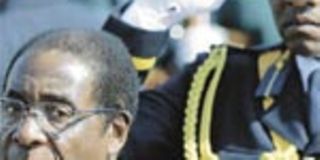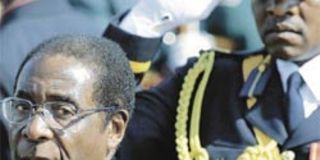Premium
Film reveals horror details of the Ndebele massacre

President Robert Mugabe in this file picture. A documentary, shown for the first time in South Africa yesterday, has survivors of the 1983 Ndebele massacre during the early days of his regime recounting their ordeal.
On August 3, 1983, President Robert Mugabe created Zimbabwe’s Fifth Brigade from soldiers drawn from the military wing of his ruling Zimbabwe African National Union Patriotic Front (ZANU-PF). The brigade was known as gukurahundi, (rain that washes away trash), a name that was soon given to the government operation they undertook.

President Robert Mugabe in this file picture. A documentary, shown for the first time in South Africa yesterday, has survivors of the 1983 Ndebele massacre during the early days of his regime recounting their ordeal.
Over the next four years, Operation Gukurahundi would terrorise members of the Ndebele community throughout southern Zimbabwe because of the perceived threat they posed to Mugabe and his predominantly Shona regime. By the time it ended, at least 20,000 people are alleged to have been killed.
“It’s an episode you never hear brought up in conversation,” says Zenzele Ndebele, the soft-spoken 29-year-old journalist who has just released the first documentary ever made on the subject. “Twenty-seven years after independence, people are still afraid to bring it up. I’m not going to make a penny off this documentary, but if it generates some dialogue I’ll be happy.”
Gukurahundi: A Moment of Madness is a 25-minute investigation into what many observers have labelled an attempted genocide. Given the current climate of fear in Zimbabwe, gathering interviews from survivors was an exceptional challenge.
“Everybody here knows someone who was affected by Gukurahundi,” says Ndebele, who lives near where most of the atrocities were committed, in the southern city of Bulawayo.
“But it was very, very hard to find anyone who would open up. Of those who agreed to talk, several changed their minds afterwards — they would call and ask me not to include them in the footage. So I had to cut the film from 45 to 25 minutes. What you see is just a fraction of what actually occurred.”
That fraction seems horrifying enough. Archived footage of a young Mugabe calmly promising to “crush the dissidents, completely,” is counterposed with present-day interviews in which some of those “dissidents” who survived reveal the ordeals they were put through.
Mine shaft
One man describes scores of young men being pushed down a mine shaft; those who resisted were shot and thrown in, until the shaft filled with bodies and another had to be found. Another recounts how, as a young boy, he was ordered to set fire to the house in which soldiers had locked 30 of his family members.
“Luckily,” he says, “a rain storm broke out after the soldiers left, and put the fire out.”
It was a rare reprieve in a narrative of slaughter and denial that bears some sinister parallels to the present.
Newspaper headlines from the mid-1980s show Mugabe’s government government denying any wrongdoing.
“Of course when you’re fighting a war, you expect people to complain of excessive force,” explains a smooth-faced Mugabe, inviting his accusers to prove their allegations.
Today, those same denials and calls for proof of what everyone knows to be happening are offered in response to allegations of police brutality against members of Zimbabwe’s main opposition party, the Movement for Democratic Change (MDC).
Gukurahundi demonstrates how the government erases its own misdeeds.
One veteran journalist describes how Fifth Brigade soldiers escorted him to the site of a mass grave.
“We knew the victims had been buried here,” he says. “But by the time the army let us near, they had exhumed and burned the bodies. The grave was empty, and all that was left were ashes everywhere.”
Elsewhere, doctors’ reports that documented the stab wounds and marks of torture on innocent civilians were denounced as lies; such reports were used as proof of treason against the very doctors who made them.
On December 22, 1987, the government signed the Unity Accord, which put an end to the fighting. Gukurahundi disappeared from the collective memory, replaced by a surreal peace which, at first glance, appears to reign even to this day.
“If you didn’t know what was going on in this country, you’d think everything was normal,” says Ndebele. But his own experience attests that not far under the surface, things are anything but peaceful.
For one thing, he and his cameramen had to keep the entire project under wraps while they were filming. “Whenever we drove out for an interview, we’d bring a tape of a funeral and put it into the camera,” he recalls. “That way, if we were stopped at a roadblock — which happened often — and they asked us what we were doing, we would just say we were coming back from filming a funeral. The real footage we would hide elsewhere in the car.”
Nevertheless, police intelligence officers got wind of what he was up to and called him in one day.
“They accused me of plotting to bomb the president,” Ndebele says, laughing at the absurdity of the claim. “All sorts of ridiculous accusations. But eventually they had to let me go.”
But the completion of the documentary did not bring an end to such hassles. To begin with, he had to sneak across the border into South Africa for the movie’s debut.
“There was no way we could show it in Zimbabwe,” he told this writer the day before he left. “So I arranged to do it in Johannesburg. But although I sent my passport off three weeks ago for a travel visa, I still haven’t gotten it back. They think all Zimbabweans want to stay permanently in South Africa — they don’t realise some of us are enjoying the chaos here at home.”
By Ndebele’s own admission, that enjoyment is about to be tested. He fully expects the police to lock him up once the movie is out in distribution. And yet, asked if he is worried about where that may lead, he shrugs.
“They can’t do anything to me legally,” he says. “Maybe they’ll beat me up. Let them. It will be good for history.”
President Robert Mugabe in this file picture. A documentary, shown for the first time in South Africa on Saturday, has survivors of the 1983 Ndebele massacre during the early days of his regime recounting their ordeal.




